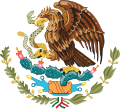This article has multiple issues. Please help improve it or discuss these issues on the talk page . (Learn how and when to remove these messages)
|
Mexico has a thriving, diverse economy with strong macroeconomic institutions and is open to trade and private investment. [1] With a population of over 130 million, Mexico is filled with citizens in the upper middle income bracket. Its economy is the 11th fastest growing in the world. [2] Low growth rates and significant inequalities continue to hamper the growth of the Mexican economy. This is a central issue and is addressed in the systematic country diagnostic. [3] The World Bank Group (WBG) discussed its support for the new Country Partnership Framework (CPF) for Mexico on February 27, 2020. The CPF covers a six-year period (2020-2025) and aligns the WBG’s engagement with the government’s National Development Plan. The CPF builds on the analysis of the Systematic Country Diagnostic (SCD) and reflects the views and strategy of the authorities on the way to foster growth and poverty reduction. [4]
Contents



